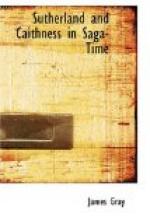From what has been above stated, it will appear that we have treated the well known history, intituled The Genealogie and Pedigree of the Earles of Southerland and written down to 1630 by Sir Robert Gordon, Baronet of Gordonstoun, and continued by Gilbert Gordon of Sallach[52] until 1651, as mere fiction as regards all persons before William, first Earl. “Alane Southerland, Thane of Southerland,” Walter “first Earle,” Robert, second earl, who is alleged to have founded “Dounrobin Castell” were purely fictitious persons. “Hugh Southerland, Earle of Southerland nicknamed Freskin” existed, but never was an earl, as Sir Robert well knew, because he quotes charters right up to his death, in which he was styled simply Hugo Freskyn. The Sutherland Book also wholly omits William MacFrisgyn, second Lord of Duffus and Strabroc, the son and heir of Freskyn I and the father of Hugo. A revised pedigree of the early generations of Freskyn’s family will be found in an Appendix to this book, and it is believed to be correct. At the same time it is in conflict as to the first three generations with so high an authority as the late Cosmo Innes, and Sir William Fraser followed him. However this may be, it is abundantly clear, from contemporary and undoubtedly authentic records still happily extant, that in the twelfth century Freskyn de Moravia and his immediate successors were the guardians appointed by one Scottish king after another to protect the fertile coast lands of Moray and Nairn alike against the race of MacHeth from the hills and the Norse invader from the sea; and that on the extensive territories which they possessed, they built stately castles and endowed cathedrals and churches with lands and tithes, providing from their family not only high ecclesiastical dignitaries to serve them, but distinguished soldiers and administrators to give them peace; services which their successors in the thirteenth century were, in their turn, destined to repeat and continue in Sutherland, Strathnavern and Caithness, when the old Norse earldom there had been broken up and effectively incorporated in the kingdom of Scotland.
CHAPTER VIII.
Earls David and John.
On the death of Earl Harold Maddadson in 1206, he was followed in the earldom of Orkney, without Shetland, by his elder surviving son, David, who also, it would seem, was allowed to succeed to the Caithness earldom and some of its territory. But out of the Caithness earldom there had been taken the lands forming the Lordship of Sudrland or Sutherland held by Hugo Freskyn from about 1196, and this comprised, as already stated, the parishes of Creich, (then including Assynt), Dornoch, Rogart, Kilmalie (now Golspie), Clyne, Loth, and by far the greater part of the parishes of Kildonan and Lairg. Out of these lands Hugo granted, as already stated, to his relative Gilbert de Moravia, Archdeacon of Moray from 1204 till 1222, and to his heirs and




